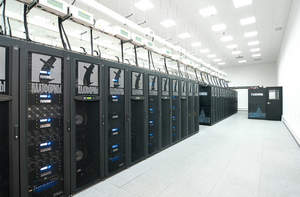SANTA CLARA, CA--(Marketwire - Jun 15, 2011) - As Russian scientists increasingly deploy GPU-enabled supercomputers to tackle scientific challenges, Moscow State University is upgrading its Lomonosov system with NVIDIA Tesla™ GPUs to be one of the world's fastest supercomputers.
The upgraded system couples 1,554 NVIDIA Tesla X2070 GPUs with an identical number of quad-core CPUs, delivering an expected 1.3 petaflops of peak performance, placing at number 1 in Russia and amongst the fastest systems in the world.
The system is used for research focused on computationally intensive areas such as global climate change, ocean modeling, post-genomic medicine, and galaxy formation.
"Our research requires enormous computational resources, and we need to deliver this performance as efficiently as possible," said Victor Sadovnichy, academician, Rector of Moscow State University. "The only way for us to achieve these twin goals is with a hybrid GPU/CPU based system."
Supercomputing centers all over the world are looking at ways to increase performance without exceeding power budgets. GPUs deliver high performance per watt, an advantage that is being leveraged across many research centers in Russia including the Keldysh Institute of Applied Mathematics; Lobachevsky State University of Nizhni Novgorod (NNSU); and the Scientific and Educational Center of Parallel Computing at Perm State University.
The Keldysh Institute of Applied Mathematics uses the computing power of 192 Tesla C2050 GPUs for research in the fields of atomic energy, aircraft building and oil extraction. NNSU is Russia's first CUDA Research Center, actively using GPUs across projects such as studying living systems via solid mathematical modeling and large-scale computation. NNSU will install a GPU-enabled cluster with a peak performance of 100 teraflops this year, with a plan to increase this to 500 teraflops by the end of 2012.
"There is a staggering potential for GPU/CPU-based systems hybrid solutions to help us address a great number of scientific challenges such as studying living systems, bio-photonics and computational mathematics," said Victor Gergel, Dean of the computational mathematics and cybernetics department at NNSU, director of Scientific and Research Institute of Applied Mathematics and Cybernetics. "In cooperation with NVIDIA, NNSU is able to give more of our students and researchers access to computational resources that will significantly increase the pace of their work."
For more information on Tesla high performance computing products, please go here.
About NVIDIA
NVIDIA (
Certain statements in this press release including, but not limited to, statements as to: the availability, benefits and impact of NVIDIA Tesla GPUs; and the impact of the company's patents on modern computing; are forward-looking statements that are subject to risks and uncertainties that could cause results to be materially different than expectations. Important factors that could cause actual results to differ materially include: our reliance on third parties to manufacture, assemble, package and test our products; global economic conditions; development of faster or more efficient technology; the impact of technological development and competition; design, manufacturing or software defects; changes in consumer preferences or demands; changes in industry standards and interfaces; unexpected loss of performance of our products or technologies when integrated into systems; as well as other factors detailed from time to time in the reports NVIDIA files with the Securities and Exchange Commission, or SEC, including its Form 10-Q for the fiscal quarter ended May 1, 2011. Copies of reports filed with the SEC are posted on the company's website and are available from NVIDIA without charge. These forward-looking statements are not guarantees of future performance and speak only as of the date hereof, and, except as required by law, NVIDIA disclaims any obligation to update these forward-looking statements to reflect future events or circumstances.
© 2011 NVIDIA Corporation. All rights reserved. NVIDIA, the NVIDIA logo, CUDA, and Tesla, are trademarks and/or registered trademarks of NVIDIA Corporation in the U.S. and other countries. Other company and product names may be trademarks of the respective companies with which they are associated. Features, pricing, availability, and specifications are subject to change without notice.
Contact Information:
For further information, contact:
Andrew Humber
NVIDIA
(408) 486-8138
ahumber@nvidia.com
